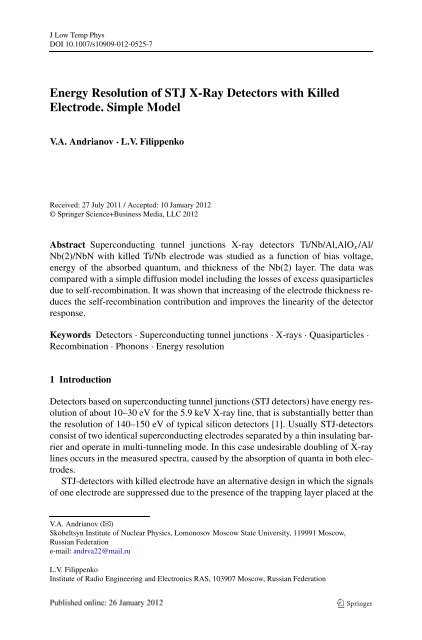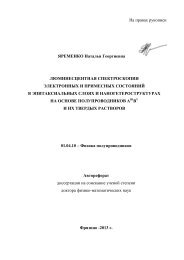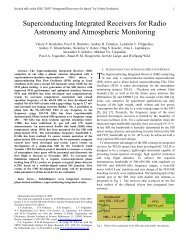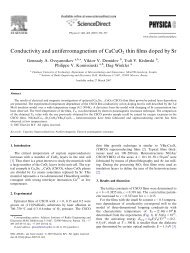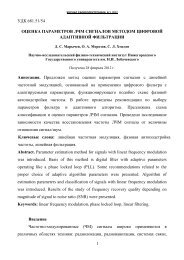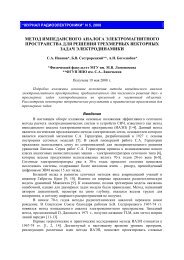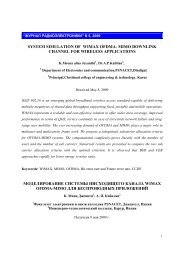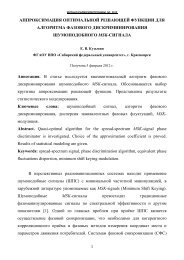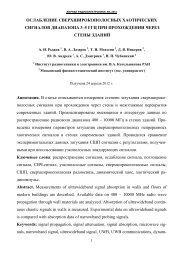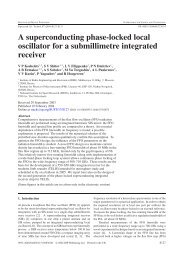Energy Resolution of STJ X-Ray Detectors with Killed Electrode ...
Energy Resolution of STJ X-Ray Detectors with Killed Electrode ...
Energy Resolution of STJ X-Ray Detectors with Killed Electrode ...
Create successful ePaper yourself
Turn your PDF publications into a flip-book with our unique Google optimized e-Paper software.
JLowTempPhys<br />
DOI 10.1007/s10909-012-0525-7<br />
<strong>Energy</strong> <strong>Resolution</strong> <strong>of</strong> <strong>STJ</strong> X-<strong>Ray</strong> <strong>Detectors</strong> <strong>with</strong> <strong>Killed</strong><br />
<strong>Electrode</strong>. Simple Model<br />
V.A. Andrianov · L.V. Filippenko<br />
Received: 27 July 2011 / Accepted: 10 January 2012<br />
© Springer Science+Business Media, LLC 2012<br />
Abstract Superconducting tunnel junctions X-ray detectors Ti/Nb/Al,AlO x /Al/<br />
Nb(2)/NbN <strong>with</strong> killed Ti/Nb electrode was studied as a function <strong>of</strong> bias voltage,<br />
energy <strong>of</strong> the absorbed quantum, and thickness <strong>of</strong> the Nb(2) layer. The data was<br />
compared <strong>with</strong> a simple diffusion model including the losses <strong>of</strong> excess quasiparticles<br />
due to self-recombination. It was shown that increasing <strong>of</strong> the electrode thickness reduces<br />
the self-recombination contribution and improves the linearity <strong>of</strong> the detector<br />
response.<br />
Keywords <strong>Detectors</strong> · Superconducting tunnel junctions · X-rays · Quasiparticles ·<br />
Recombination · Phonons · <strong>Energy</strong> resolution<br />
1 Introduction<br />
<strong>Detectors</strong> based on superconducting tunnel junctions (<strong>STJ</strong> detectors) have energy resolution<br />
<strong>of</strong> about 10–30 eV for the 5.9 keV X-ray line, that is substantially better than<br />
the resolution <strong>of</strong> 140–150 eV <strong>of</strong> typical silicon detectors [1]. Usually <strong>STJ</strong>-detectors<br />
consist <strong>of</strong> two identical superconducting electrodes separated by a thin insulating barrier<br />
and operate in multi-tunneling mode. In this case undesirable doubling <strong>of</strong> X-ray<br />
lines occurs in the measured spectra, caused by the absorption <strong>of</strong> quanta in both electrodes.<br />
<strong>STJ</strong>-detectors <strong>with</strong> killed electrode have an alternative design in which the signals<br />
<strong>of</strong> one electrode are suppressed due to the presence <strong>of</strong> the trapping layer placed at the<br />
V.A. Andrianov ()<br />
Skobeltsyn Institute <strong>of</strong> Nuclear Physics, Lomonosov Moscow State University, 119991 Moscow,<br />
Russian Federation<br />
e-mail: andrva22@mail.ru<br />
L.V. Filippenko<br />
Institute <strong>of</strong> Radio Engineering and Electronics RAS, 103907 Moscow, Russian Federation
JLowTempPhys<br />
side opposite to tunnel barrier [2]. The main detector signal arises from the quantum<br />
absorption in the opposite electrode. The advantages <strong>of</strong> this detector type should be<br />
the absence <strong>of</strong> line doubling and short duration <strong>of</strong> the signals.<br />
In our work [3], the <strong>STJ</strong> detectors <strong>with</strong> killed electrode on the basis <strong>of</strong> the additional<br />
titanium trapping layer were proposed. The general sequence <strong>of</strong> layers was<br />
described by the formula Ti/Nb/Al,AlO x /Al/Nb/NbN. The bottom killed electrode<br />
consisted <strong>of</strong> two layers: a Ti trapping layer and a thicker Nb layer. The main top electrode<br />
had three layers: thin Al trapping layer, the main absorbing Nb layer, and the<br />
outer reflecting NbN layer. Unfortunately the achieved energy resolution was about<br />
90 eV for 5.9 keV line. In this work the main parameters <strong>of</strong> these detectors were<br />
studied as a function <strong>of</strong> the bias voltage, the energy <strong>of</strong> the absorbed quanta, and <strong>of</strong><br />
the thickness <strong>of</strong> Nb layers. Data are analyzed on basis <strong>of</strong> a simple diffusion model<br />
<strong>with</strong> quasiparticle self-recombination.<br />
2 The Diffusion Model <strong>of</strong> <strong>STJ</strong>-<strong>Detectors</strong><br />
The main reason <strong>of</strong> degradation <strong>of</strong> energy resolution <strong>of</strong> X-ray <strong>STJ</strong>-detectors is spatial<br />
dependence <strong>of</strong> the detector signal on the photon absorption site. The amplitude<br />
<strong>of</strong> the signal is usually reduced as the photon absorption point approaches to<br />
the electrode edge. The data are considered in a framework <strong>of</strong> diffusion model <strong>of</strong><br />
<strong>STJ</strong>-detectors. There are two main mechanisms <strong>of</strong> line broadening: the quasiparticle<br />
self-recombination [4, 5] and the edge losses <strong>of</strong> the excess quasiparticles [2]. The<br />
self-recombination causes the nonlinearity <strong>of</strong> the detector response versus the energy<br />
<strong>of</strong> the absorbed phonon as well.<br />
Figure 1 shows the dependence <strong>of</strong> the signal amplitude Q on the coordinate <strong>of</strong><br />
the quantum absorption x 0 , obtained by a diffusion model for a single electrode. a is<br />
a linear size <strong>of</strong> an electrode. We remind that the signal amplitude is proportional to<br />
the total number <strong>of</strong> tunneled quasiparticles. If the edge losses and self-recombination<br />
losses are absent, then the signal Q does not depend on the coordinate x 0 .Inthis<br />
Fig. 1 (Color online) The<br />
dependences <strong>of</strong> the signal<br />
amplitude Q on the coordinate<br />
<strong>of</strong> a quantum absorption x 0 ,<br />
obtained by a diffusion model<br />
(scheme). (1) Q R = 0,<br />
Q B = 0. (2) Q R ≠ 0,<br />
Q B = 0. (3) Q R ≠ 0,<br />
Q B ≠ 0
JLowTempPhys<br />
case the detector should have thin spectral line. Its width is determined by tunneling<br />
fluctuations and by an electronic noise.<br />
The self-recombination losses reduce signal Q in the center <strong>of</strong> electrode by Q R<br />
and at the edge <strong>of</strong> electrode approximately by 2Q R (curve2inFig.1). The edge<br />
losses additionally reduce the signal Q by Q B near the electrode boundary only<br />
(curve 3 in Fig. 1). The dependence <strong>of</strong> signal Q on the coordinate (x 0 ,y 0 ) causes<br />
strong broadening <strong>of</strong> the detector line. Changing <strong>of</strong> Q(x 0 ) takes place in a strip near<br />
the electrode edge <strong>with</strong> the width approximately equal to the quasiparticle diffusion<br />
length = √ Dτ d , where D is the quasiparticle diffusion coefficient and τ d is the<br />
quasiparticle lifetime. The lifetime τ d is determined by the quasiparticle tunneling<br />
rate γ T and the loss rate γ L : τ d = (γ T + γ L ) −1 . To narrow the detector line it is<br />
necessary to reduce the values Q R , Q B and the ratio (/a) (see Fig. 1).<br />
The edge losses Q B depend on the methods <strong>of</strong> tunnel junction production. The<br />
ratio (/a) first <strong>of</strong> all depends on the detector sizes. The recombination losses Q R<br />
can be described by the formula [6]:<br />
( ) E 2 ( )<br />
R ef <br />
Q R = P 1<br />
1.75 t 2πD ln , (1)<br />
1.89a 0<br />
where P 1 is the quasiparticle tunnel probability, E is the energy <strong>of</strong> the absorbed<br />
quantum, a 0 is the initial radius <strong>of</strong> the excess quasiparticles distribution, and R ef is<br />
the effective recombination coefficient. In the case <strong>of</strong> a homogeneous electrode R ef<br />
is equal to<br />
R ef = R d<br />
η<br />
4<br />
(<br />
l2<br />
d<br />
)(<br />
1 + η 4<br />
(<br />
l2<br />
d<br />
)) −1<br />
, (2)<br />
where R is the recombination coefficient [7], η is the transparency <strong>of</strong> the electrode<br />
interface for 2-phonons; l 2 is an average free path <strong>of</strong> 2-phonons, l 2 = v s τ pb ≈<br />
13 nm, where v s is the sound velocity and τ pb is the pair breaking time for 2phonons<br />
[7]; d is the thickness <strong>of</strong> the electrode. From formulae (1) and (2) and Fig. 1<br />
it follows that increasing <strong>of</strong> the electrode thickness d should decrease the recombination<br />
losses and consequently should improve the energy resolution. This conclusion<br />
was tested by experiment.<br />
3 Experiment and Discussion<br />
The samples <strong>of</strong> <strong>STJ</strong>-detectors Si-substrate/Ti/Nb/Al,AlO x /Al/Nb(2)/NbN were fabricated<br />
by magnetron sputtering. Five rhomb-shaped <strong>STJ</strong> detectors <strong>with</strong> a ratio <strong>of</strong><br />
diagonals <strong>of</strong> 2:1 or 4:1 and different electrode areas, S = 400, 400, 1600, 6400, and<br />
20000 µm 2 , were arranged on one chip. The scheme <strong>of</strong> the <strong>STJ</strong>-detector is shown<br />
in Fig. 2. The layer thicknesses were as follows: Ti and NbN (30 nm each), base<br />
Nb layer (100 or 150 nm), Al/AlO x oxide layer (4 nm/2 nm), top Nb(2) layer (150,<br />
200, or 250 nm), and trapping top Al layer (11–13 nm). The width <strong>of</strong> current leads<br />
was about 10 µm. The superconducting gaps for the bottom and top electrodes were<br />
base = 1.36 meV and top ≈ 0.95 meV. The normal resistance <strong>of</strong> the tunnel barrier<br />
was R N S ≈ 400 µm 2 . The best resolution was achieved for detectors <strong>with</strong> maximum<br />
areas S = 6400 and 20000 µm 2 .
JLowTempPhys<br />
Fig. 2 Scheme <strong>of</strong> the<br />
<strong>STJ</strong>-detector: 1—Si substrate;<br />
2—the base lead (Nb/Ti); 3—Ti<br />
trapping layer; 4—Nb base<br />
layer; 5—isolating layer<br />
(Al 2 O 3 ); 6—SiO 2 isolation;<br />
7—Al trapping layer <strong>of</strong> the top<br />
electrode; 8—Nb top layer;<br />
9—NbN outer layer; 10—the<br />
top lead (Nb)<br />
Fig. 3 (Color online) Bias<br />
voltage dependence <strong>of</strong> the initial<br />
slope a ini (a) andthe<br />
nonlinearity b (b)<br />
The pulse height spectra were measured at different bias voltages V d at the<br />
temperature 1.25 K. The samples were irradiated by MnK α and MnK β X-rays<br />
(5.9 and 6.4 keV) from a 55 Fe radioactive source, by fluorescent TiK α and TiK β<br />
X-rays (4.5 and 4.9 keV) from a Ti foil shield placed around the source and <strong>with</strong><br />
fluorescent SiK α X-rays from Si substrate [5].<br />
The detectors had noticeable nonlinearity <strong>of</strong> the response relative the energy <strong>of</strong><br />
the quantum. The dependence Q(E) was determined at every bias voltage and was<br />
described by the formula [6]:<br />
Q(0) = a ini E(1 − bE), (3)<br />
where a ini is the initial slope coefficient and b is the nonlinearity coefficient. Expressions<br />
for a ini and b follow from formula (1):<br />
a ini = P 1<br />
, b= 1 ( )<br />
R ef <br />
1.7 t 1.7 t 2πD ln . (4)<br />
1.89a 0<br />
Figure 3 shows the dependences <strong>of</strong> coefficient a ini and nonlinearity b on the detector<br />
voltage V d for several samples. a ini (V d ) has a maximum and the b(V d ) has a
JLowTempPhys<br />
Fig. 4 (Color online)<br />
Quasiparticle lifetime τ d-top as<br />
function <strong>of</strong> thickness <strong>of</strong><br />
Nb(2)-layers. Labels show the<br />
thickness <strong>of</strong> Al-trapping layers<br />
in top electrodes in nm<br />
minimum at the voltage V d ≈ ( base − top )/e. This behavior is explained by the<br />
maximum in the tunneling rate γ T for the electrode <strong>with</strong> a narrower band gap in the<br />
asymmetric tunnel junction [6]. The maximum in γ T is accompanied <strong>with</strong> the minimum<br />
in τ d and . One can see from Fig. 3b that detectors <strong>with</strong> thicker top electrode<br />
have lower nonlinearity b. This means that increasing <strong>of</strong> the electrode thickness d<br />
really decrease the recombination losses Q R .<br />
Unfortunately changing <strong>of</strong> the electrode thickness did not improve the energy resolution.<br />
For all samples the best energy resolution at V d ≈ ( base − top )/e was about<br />
90 eV at 5.9 keV. This behavior can be explained by changing <strong>of</strong> quasiparticle lifetime<br />
τ d . Figure 4 shows the dependence <strong>of</strong> the lifetime τ d on the thickness <strong>of</strong> Nb layer. The<br />
lifetime τ d was determined as a risetime <strong>of</strong> signal pulses at V d ≈ ( base − top )/e.<br />
One can see that the thicknesses <strong>of</strong> Nb layer and Al layer influence the quasiparticle<br />
lifetimes. In particular, increasing <strong>of</strong> the thickness <strong>of</strong> Nb layer increases the lifetime.<br />
This means that the diffusion length increases also. As the result, the factor<br />
(/a) deteriorates the energy resolution. Changing <strong>of</strong> τ d <strong>with</strong> the thickness <strong>of</strong> the<br />
layers is due to the tunneling rate γ T . This means that the Al/Nb quasiparticle trap in<br />
this range <strong>of</strong> the layer thicknesses is not saturated. To exclude the dependence <strong>of</strong> τ d<br />
on the electrode thickness one has to select thicker Al layers and consequently deeper<br />
quasiparticle traps.<br />
4 Conclusion<br />
The experimental data obtained for <strong>STJ</strong>-detectors <strong>with</strong> killed electrode are consistent<br />
<strong>with</strong> a simple diffusion model. It is shown that the self-recombination <strong>of</strong> excess<br />
quasiparticles gives the noticeable contribution to line broadening. Increasing <strong>of</strong> the<br />
electrode thickness reduces the self-recombination losses and improves the linearity<br />
<strong>of</strong> the detector response as a function <strong>of</strong> the photon energy. The improvement <strong>of</strong> energy<br />
resolution in <strong>STJ</strong>-detectors under study is blocked by decreasing <strong>of</strong> tunneling<br />
rate <strong>with</strong> increasing <strong>of</strong> the top electrode thickness. To improve energy resolution, the<br />
usage <strong>of</strong> thicker Al trapping layers is recommended.<br />
The confirmation <strong>of</strong> the diffusion model was obtained in some other publications<br />
also [1]. The only exception is the series <strong>of</strong> the works performed by the lowtemperature<br />
scanning synchrotron microscope method [8, 9]. The abnormal behavior
JLowTempPhys<br />
observed in these works may be considered as an evidence <strong>of</strong> an additional mechanism<br />
<strong>of</strong> the resolution degradation which appears in <strong>STJ</strong>-detectors <strong>with</strong> large electrode<br />
sizes and deep quasiparticle traps.<br />
Acknowledgements This study was supported by the Ministry <strong>of</strong> Education and Science <strong>of</strong> the Russian<br />
Federation (Contract No. 02.740.11.0242).<br />
References<br />
1. P. Lerch, A. Zender, in Quantum Giaever <strong>Detectors</strong> in Cryogenic Particle <strong>Detectors</strong>, ed. by C. Enss.<br />
Topics in Applied Physics, vol. 99 (Springer, Berlin, 2005), pp. 217–265<br />
2. J. Gomez, O.J. Luiten, H.L. van Lieshout, M.L. Van den Berg, M. Bruijn, F.B. Kiewiet, P.A.J. de Korte,<br />
Czechoslov. J. Phys. 46, 2905 (1996)<br />
3. M.G. Kozin, I.L. Romashkina, S.A. Sergeev, L.V. Nefedov, V.A. Andrianov, V.N. Naumkin, V.P.<br />
Koshelets, L.V. Filippenko, Nucl. Instrum. Methods Phys. Res. A 520, 250 (2004)<br />
4. G. Kozorezov, J.K. Wigmore, R. den Hartog, D. Martin, P. Verhoeve, A. Peacock, Phys. Rev. B 66,<br />
094510 (2002)<br />
5. V.A. Andrianov, L.V. Filippenko, V.P. Gorkov, V.P. Koshelets, Nucl. Instrum. Methods Phys. Res. A<br />
559, 683 (2006)<br />
6. V.A. Andrianov, L.V. Filippenko, V.P. Gorkov, V.P. Koshelets, J. Low Temp. Phys. 151, 1049 (2008)<br />
7. S.B. Kaplan, C.C. Chi, D.N. Landberg, J.J. Chang, S. Jafarey, D.J. Scalapino, Phys. Rev. B 14, 4854<br />
(1976)<br />
8. H. Pressler, M. Ohkubo, M. Koike, T. Zama, D. Fukuda, N. Kobayashi, IEEE Trans. Appl. Supercond.<br />
11, 696 (2002)<br />
9. M. Ohkubo, M. Ukibe, T. Zama, T. Ikeuchi, M. Katagiri, S. Ichimura, Nucl. Instrum. Methods Phys.<br />
Res. A 444, 231 (2004)


